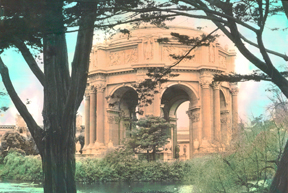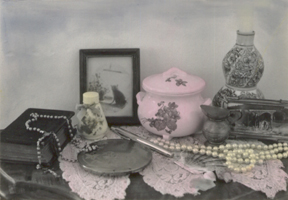Hand-TINTING PHOTOGRAPHS
by Joelle Steele
 When photography was first introduced in the early 19th century – more than 150 years ago – it was an incredible and exciting novelty. However, within a very short time – just a couple of years after Daguerreotypes first appeared – there was one glaring problem: they lacked color.
When photography was first introduced in the early 19th century – more than 150 years ago – it was an incredible and exciting novelty. However, within a very short time – just a couple of years after Daguerreotypes first appeared – there was one glaring problem: they lacked color.
Photographers had immediately introduced editing and retouching in the darkroom. They used multiple negatives to create composite photos and montages, they blurred and softened portions of an image and darkened others, and they used inks and knives to draw or etch directly onto negatives to enhance details. So, the idea of incorporating color into a photo was certainly not unexpected.
Many attempts were made to create color photographs, but all had failed. A very viable alternative at the time was to simply add color to photographic images. The first American patent for coloring Daguerreotypes went to Benjamin Stevens and Lemuel Morse of Lowell, Massachusetts. Their method involved coating the surface with varnish or gum and then painting over it. A second American patent for hand-coloring photographs was granted that same year, and there were different photographic processes, so these each necessitated different techniques for coloring the images. In general, there were two methods of coloring. There was hand-tinting (also called hand-coloring), which was done by lightly painting over an image so that you could still tell it was a photograph when you were done. And the other was over-painting, in which heavier pigment was applied, often obscuring the photograph entirely.
The quality of these manually-colored photographs varied considerably according to the skill of the individual doing the work, usually, but not always, a woman who was called a "colorist." But in those early days, only the very rich could afford to have any kind of photograph taken, and having one that was tinted or over-painted was somewhat of a status symbol.
It was not until the more affordable tintype was introduced that anyone else could afford a photograph, let alone one that was colored. And in some cases, only portions of a tintype might be colored to reduce the costs but provide some natural flesh tones or enhance other details. As photographic prints on paper became feasible in the mid-1850s, enlarged crayon portraits became popular for a time.
Photography was popular yet controversial during its early years, and so was the practice of coloring photographs. Many artists objected to the coloring and predicted that it would ultimately usurp traditional portraiture, and many photographers believed that coloring a photograph destroyed its ability to portray subjects the way they looked in nature, unaltered and realistic. Yet, through the years, many articles and books were written about the process of coloring photographs. Even after the first color photographic process, autochrome, was invented in 1907, people continued to hand-tint photographs.
The first time I hand-tinted a photograph was in 1977. I had an enlargement of a photo I took of the Palace of Fine Arts in San Francisco. I mixed up some ordinary powder Rit fabric dyes in my watercolor palette, and then applied them to the photo with a brush. I did the same with a small still life photo. Neither was exactly one of my better works, but I they look pretty much as they did more than 30 years ago.


In the old days, photographs with plenty of gray tones – not too heavily contrasted – were the best candidates for hand-tinting. To begin the process, colorists usually coated the photo with a varnish to ensure that all parts of the photo absorbed color the same way. Light layers of color were applied until the desired shade was achieved, sometimes adding binders such as gum arabic to the pigment for better adherence. Inks were a popular media, but gold paint was also used, particularly for enhancing the appearance of jewelry, although some colorists etched the plate to bring up the silver for the same reason.
Other methods of hand-tinting involved the creation of stencils for each color to be applied, mixing dry pigment and gum arabic and sprinkling it over the stenciled areas, and then lightly breathing on it to moisten the substance and fix it. For photographs that were to have an overall color to them, a chemical bath was used.
Ambrotypes could also be colored on the back side of the image by first applying mercury bichloride, which bleached the silver on the glass and thus made the whites much more intense. Then it was hand-colored and a coat of varnish was applied to seal it, after which it was placed on a black background, usually velvet to avoid scratching the image.
Tintypes were made on black lacquered iron plates. They were an inexpensive alternative to the more costly and fragile glass-plate Daguerreotypes and ambrotypes. They were also sturdier, but the images lacked the depth of their more expensive counterparts. They were far more popular and could also be colored, though usually with oils or greased media, such as pastel and crayon, and they had to be sealed under glass. Tintype plates could also be coated with pigment and linseed oil to create an overall tint to the image.
The most commonly hand-tinted photographs were those made on paper. Pastel was a good choice for coloration. Watercolors could also be used but they tended to leave dark edges around each color if not applied carefully. Inks worked well, as did oils and aniline dyes – although the latter fell out of favor in modern times due to its carcinogenic properties. Paper prints were varnished before they were colored to achieve an even surface for the pigment, and like tintypes, they were mounted under glass to preserve their coloration.
I have hand-tinted many photographs over the years, mostly using inks after giving up the fabric dyes which, while very good in terms of color and colorfastness, are very messy to work with. I have also tried my hand at using oils to do overpainting, but did not find that process to be as attractive as tinting. I have also found that the glossier the photographic paper is, the better the end result of tinting, as matte surfaces tend to pool the color and give the image a cracked effect that does not look good aesthetically and doesn't even make for an antique look. As for overall tinting, these days I rely on Photoshop to digitally make such enhancements. Progress, you know …

